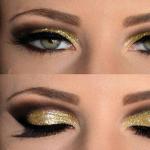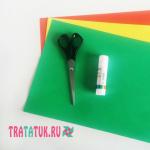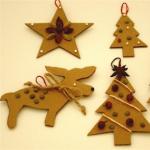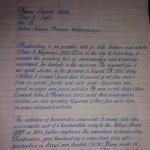How to cut and sew a round tablecloth. DIY tablecloths for tables of different shapes
Kitchen tablecloths come in oilskin, silk, linen, cotton and others, and sewing such a product or runner for festive table easy with your own hands.
Nothing gives a home such a feeling of warmth and coziness as an elegant tablecloth. Bought in a store or sewn with your own hands, it can completely transform the entire room. Previously, this interior detail was considered luxury, sometimes receiving the disdainful clarification - bourgeois. But capricious fashion has a pleasant habit of returning. So now a tablecloth can be laid on the table not only on holidays, and not just in the kitchen. The choice of this textile element and sewing it yourself is described below.
Fabrics for all occasions
Tablecloths are still usually divided into festive and everyday. But within this simple classification, “narrow-profile” options also appeared. Festive ones varied with New Year's, Easter, children's and wedding patterns. And among everyday models you can now find tea rooms, dining rooms and those designed to simply complement the interior. First, let's decide what materials they should be made from.
Daily Materials:
- Oilcloth: the cheapest and most unpretentious option - oilcloth tablecloths - have nothing to do with fabrics. Perfect for a simple family dinner on a weekday. But at the dacha there is simply no price for such unpretentious material. Buy several bright models at once for tables in the kitchen, terrace and gazebo (if you have one).
- Polyester: also a relatively inexpensive material that tolerates regular washing by hand or in a machine and does not require tedious ironing afterwards.
- Jacquard: these tablecloths with a double-sided pattern can easily be called “2 in 1”. They look different on the front and back sides, so you can rearrange them as you please depending on your mood (or when stubborn stains appear). Jacquard fabrics more dense, therefore they last longer than others.

From holiday options There are three main fabrics for tablecloths.
Cotton
Tablecloths made from natural cotton with Teflon or acrylic waterproof coatings. It is this material that can withstand the endless flow of visitors to cafes and restaurants, as well as regular washing in not the most gentle conditions. Special impregnations protect cotton from stains, hot dishes and spilled drinks. At the same time, the tablecloth does not stand up like a stake, but can flow beautifully, descending from the edge of the tabletop.
Linen
Unfortunately, delicate flax is not subjected to protective treatment. Therefore, the beauty of linen tablecloths with lace or embossed patterns, luxurious hand-made embroidery - alas, is short-lived. It is almost impossible to wash stained fabric, so linen is often used as the basis for multi-layer draperies.
Natural cotton and linen fabrics The good thing is that they can be used both on a weekday and for festive table setting. The addition of polyester fibers makes them more practical and does not spoil the appearance at all.
To keep neat appearance tablecloths, the table on top of it is covered with thick jacquard runners or a shorter naperon. The exquisitely decorated edges of the linen tablecloth will remain visible at the level of the table legs, and the center will be reliably protected from stains.

Silk
Expensive silk fabrics are rarely used for dining tables. But they look great in the interior: on cabinets and chests of drawers. However, at a wedding banquet it is difficult to imagine something more luxurious than thin flowing silk with skillful embroidery.
Tablecloth shape
The tabletop will determine what shape the tablecloth should be. Some table models are friends only with their geometric copies, others allow combinations. It is imperative to know these subtleties.
- Rectangular tabletop: only the same rectangular tablecloths are suitable for it. There is no other way to cover a traditional table. However, special tracks (runners or runners) add some variety. But they also have a rectangular shape.
- Square tabletop: covered according to the same principle - only with square cuts. But no one is stopping you from making an interesting two-layer covering with your own hands by laying two tablecloths of different colors and sizes crosswise. You can often see this technique in photos of designer kitchens. By the way, a path on a square table would be inappropriate.
- Circle: both a square and a round tablecloth, or even both together, look great on this tabletop. The main thing when covering the table is to accurately find the center of the cuts and make sure that the drapery is distributed evenly.
- Oval tables: these original models are also unpretentious - both textile ellipses and elegant rectangular tablecloths are suitable for them.

Choosing a size
Having figured out the shape, we move on to the important stage of choosing a tablecloth for a table of a suitable size. When going to the store, don’t be too lazy to measure the countertop with your own hands using a tape measure and write down or remember the result. When purchasing, focus on those products that are guaranteed to hang another 20-30 cm from the edge.
You can determine the optimal length of the tablecloth by placing a chair next to the table. Ideally, the edge of the drapery should hang down just to the level of the seat - not lower.
Models that turn out to be longer have a right to exist in your home, but you shouldn’t overdo it. Take 40 cm as the maximum allowable length of hanging drapery and try not to buy tablecloths bigger size. In photos of fashionable interiors and in modern restaurants, floor-length tablecloths look very beautiful. But imagine for a moment how your guests will begin to get their feet tangled in these draperies, trying to get up from the table. It's good if it doesn't end in a fall or broken dishes. It is better to avoid short tablecloths altogether. The only exception may be the covers that you will lay on top of the main fabric.
There are also requirements for the width of table paths. The size of the textile strip should not be wider than half the table. For large tabletops, you can use runners measuring only 30-40 cm, using them to “outline” the table into separate zones. Don't forget that the main purpose of the runner is to protect the tablecloth from stains. Therefore, lay out the paths so that the utensils for each person sitting at the table are conveniently located on them.

Instead of a runner, you can use more conservative cloth napkins. As a rule, good holiday tablecloths come already included. Their only difference from the table runner is that small napkins are used only at lunch, while the runner can serve simple decoration table and the rest of the time.
Colors
Light colors have been and remain the most popular - they always look elegant. Such tablecloths will be appropriate for any occasion, be it a regular family dinner or gala event. But with more saturated shades, you need to choose the right tactics, dividing them into cold and warm colors:
- Green, blue, blue - these cool shades slightly reduce appetite, but also calm the nerves. If people who cannot restrain their emotions gather at the table, such tablecloths will help smooth out the situation a little.
- All colors from red to bright yellow are not just warm - they are hot. Such tablecloths are bought by housewives who love friendly gatherings over a hearty dinner. Warm colors stimulate the appetite, so at a table covered with a bright tablecloth, no one will refuse a treat.
Try to buy tablecloths without multi-colored patterns - colorful products are more suitable for a children's sweet table or tea party in the country. Otherwise, plain fabrics would be more appropriate. And to create a beautiful color combination you can simply use multi-layer installation or bright paths.

And most importantly, the tablecloth should be in harmony with the surrounding interior. Whether it will blend in with it or attract attention with contrasting colors is up to you. As a last resort, you can order or sew chair covers from the same fabric from which the tablecloth is made. You can easily find photos and patterns on the forums of craftswomen. Then your dining room will have a full-fledged dining group, made in the same style.
We sew the tablecloth ourselves
Having understood all the intricacies of choosing the right fabrics and shapes for tablecloths, it is not difficult to make with your own hands a whole set of a wide variety of models for table decoration. Here you can accurately guess the dimensions, and original ideas bring it to life.
Sewing involves the following order of work:
- Measure the tabletop and the length of the hanging draperies of the tablecloth.
- Make a pattern according to the dimensions obtained, leaving 2.5 cm on each side for hemming the edges.
- Sew individual panels together or simply overcast the edges of the tablecloth.
- Decorate with embroidery, lace or leave as is.
If the table is large, and you will have to sew a tablecloth for it yourself from several panels, try to keep the seams out of sight. Although this kind of cutting is not the most rational, it is better to put a whole piece of material in the center and stitch the missing parts on the sides. 
Many people are familiar with the situation when buying a new tablecloth on the market - the choice is huge, but there is nothing to choose from. There the colors are faded, there the cut is poor, there the material is a little more than artificial with a corresponding smell, there the pattern of the tablecloth “goes away” after the first wash. This is especially true when the renovation is completed, the interior design is made in a certain style, and a cheap looking tablecloth with a poor pattern can ruin the entire impression of the kitchen or living room. After all, the tablecloth on the dining table is always the center of attention. What happens? If you want to do something well, do it yourself. In the case of a tablecloth, this is very possible.
How to choose a good tablecloth? Sew it yourself!
Tablecloth for the table - how to sew?

The technique of sewing a tablecloth on a table is not a state secret; on the contrary, cutting and sewing techniques are happily passed on from generation to generation. There are plenty of nuances and tricks in this matter.
Let's choose and get acquainted with the most useful of them.
Round tablecloth

Tablecloth for a square table

Tablecloth and chair covers

The tools for sewing a tablecloth are standard.
Depending on the type of tablecloth, we will need fabric, scissors, a needle and thread, rope, a tailor's ruler and square, a button and a large sheet of paper.
A button, string and pencil are used as a compass to cut out a tablecloth. round shape sew a tablecloth with your own hands Sew a tablecloth with your own hands There are a lot of options for what a tablecloth can be.

In shape it can be a tablecloth for a square, rectangular, round or oval table. In terms of its design and execution, the tablecloth can be simple with a hem seam, with appliqué, with edged seams or with lace, with an open or closed cut.

Embroidered patterns on the tablecloth Braid, hemstitch, and lambrequins are appropriate as additional elements on the tablecloth.
How to sew a round tablecloth - master class with photos
And now we will tell you how to sew a round tablecloth, and at the same time get a new table without buying it. This idea was suggested by the site http:inmyownstyle.com/2015/02/make-round-tablecloth.html
First of all, let's decide on the table: it should be round. If you don’t have one, but only have an old rectangular one that you’ve been planning to take to the landfill for a long time (you just can’t get around to it), here it is - the way out!

You just need to get (make it from old furniture or order from a private workshop) a round piece made of chipboard or plywood with the diameter we need: at least 70 cm. This will be our tabletop.
We place our circle on top of the old table, secure it with screws and that’s it, the table is ready.

Let's start sewing the tablecloth.
We will need:
Centimeter;
Scissors;
Straight pins;
Chalk or pencil;
If you are using cotton fabric Please note that it will shrink after washing. Therefore, it is better to wash and iron it first.
When cutting, be sure to add seam and hem allowances.
Operating procedure:
1. Determination of fabric consumption
Fabric consumption depends on the diameter of the future tablecloth. To find out, you need to measure:
The height of the tablecloth (from the table top to the bottom edge) on both sides;
Tabletop diameter.
Then all 3 measurements need to be added.
In this case, the measurements turned out like this (photo 1):

Table diameter - 76 cm, tablecloth height - 76 cm on each side.
Tablecloth diameter: 76 cm + 76 cm + 76 cm = 2.28 m.
Fabric consumption: 2.28 m + seam allowance + hem allowance, multiplied by 2. In this case, to sew a round tablecloth with a diameter of 2.28 m, you will need 4.6 m of fabric with a width of 110 cm.
You may need more fabric- this will depend on the size of the table.
2. Cut the fabric
The piece of fabric needs to be cut as in photo 2: in half along the transverse line, and then one piece - in half again, but along the lobar. We get three details.
The size of the central part 1 is 1.10 m wide and 2.3 m long;
The dimensions of the side parts 2 and 3 are 55 cm wide and 2.3 m long.

3. Stitching parts.
Your task is to get a square piece of fabric from which we will cut out a circle. Fold the parts as follows (photo 3):

Leave enough space for cutting fabric. Place center part 1 right side up.

Then place the side pieces face down on top and secure along the edges with pins tablecloth pattern
Do you like to receive guests? We simply love it! And that’s why we suggest you sew a tablecloth with your own hands before they arrive. Believe me, such a tablecloth will not only decorate your holiday, but will also become a source of pride for the hostess, because such a tablecloth cannot be bought in a store! Made from floral cotton tapestry, it is finished with a satin border and fine lace trim. Another special feature of this tablecloth is that it is double - placed on a thin olive-colored cotton lining.
DIY tablecloth - details
Rice. 1. DIY tablecloth - table setting
Rice. 3. Table setting - top view
DIY tablecloth - master class
In order to correctly calculate the required length of fabric for a tablecloth, measure the length and width of your table and add 60 cm to the measured values. The estimated length of the tablecloth (DS) and the finished width of the tablecloth (SH) are calculated using the formula: DS = Table width + 60 cm, ШС = Table length + 60 cm. According to the standards, the tablecloth should go down from all edges of the table by 25-30 cm.
As a rule, tablecloths purchased in stores have standard sizes and do not always fit our table, going down the edges too much or not enough. This is another reason to sew a tablecloth yourself!
Fabric for the tablecloth can be purchased at a curtain fabric store. The width of such fabrics is usually 2.8-3.0 m, which will allow you to sew a tablecloth even on a large table. Dimensions of the table presented in the master class: 0.9 m x 1.8 m.
For our tablecloth and 4 napkins we needed:
Main fabric: cotton tapestry with a floral pattern - 1.5 m with a fabric width of 2.8 m.
Lining fabric: cotton poplin 2.4 m long and 150 cm wide.
Satin ribbon for finishing the edges of the tablecloth 6.5 cm wide, 8.5 m long, lace trim 2.5 cm wide and 8.5 m long, matching threads.
For finishing the edges of napkins (napkin size 0.3 x 0.3 m): satin ribbon 3 cm wide, 5 m long, lace trim 2.5 cm wide and 5 m long, matching threads.
Rice. 1. DIY tablecloth - necessary materials
Cut out the tablecloth from the main and lining fabrics according to your measurements, add 1 cm allowances on all sides. Place both pieces with right sides facing each other, match the edges and secure with tailor's pins.
Rice. 2. Treating the tablecloth with a lining. Cut out 2 rectangles for the tablecloth from the main and lining fabric according to your measurements.
Sew the parts from the main and lining fabrics along the contour, leaving a small area for turning.
Rice. 3. Sew the parts along the contour
Cut off the allowances at the corners, not reaching 2 mm from the stitching.
Rice. 4. Cut off allowances at corners
Iron the seams of the tablecloth from the right side, placing both allowances on the main fabric piece.
Rice. 5. Iron the seams
Sweep the tablecloth clean on all sides, turning the seam to the wrong side.
Rice. 6. Sweep clean on all sides
Fold and iron the seam allowances along the open area of the tablecloth. Then fold them together, matching the edges, baste and stitch close to the edge. Remove basting stitches. Iron the tablecloth along all edges again.
Rice. 7. Fold and baste the allowances along the open area
Before setting up satin ribbon, you need to fix the edges of the tablecloth. To do this, place wide basting stitches along the edges as shown in photo 8.
Rice. 8. Baste the edges of the tablecloth using wide stitches.
Decorating the edges of the tablecloth with satin ribbon
Satin ribbon and lace trim are used to decorate the tablecloth. First, you need to stitch the satin ribbon along the edges of the tablecloth, then the lace trim is sewn onto the ribbon (Fig. 9).
Rice. 9. Satin ribbon and lace trim
Start stitching the satin ribbon from one of the corners of the tablecloth. Place it exactly along the edges and stitch exactly to the edge.
Rice. 10. How to sew satin ribbon
To make it easier for you to guide the fabric under your foot when turning a corner, thread a double thread into the top of each corner. Pull the thread as you turn to help guide the fabric under the foot.
Rice. 11. When turning the corner, pull the thread
After the satin ribbon is stitched around the entire perimeter of the tablecloth, you need to decorate the corners. To do this, lay the tape at a 90° angle and cut off the excess tape at the corner, leaving allowances for hemming the edges.
Rice. 12. Cut off the corners of the satin ribbon
Tuck one seam allowance on top of the other, fold the top seam allowance under and baste or pin.
Rice. 13. Fold and pin allowances at corners
Make sure that when folding the ribbon you get a neat, even hem. Stitch the corner allowance exactly to the edge.
Rice. 14. Stitch the tape allowance to the corner
The open edge of the ribbon can be pinned to the tablecloth or basted; we will sew lace trim along this edge.
Rice. 15. Corners of the tablecloth
The lace trim should be stitched exactly in the center. To do this, place the trim on the open edge of the satin ribbon and stitch it in the center, while simultaneously stitching the inner edge of the satin ribbon.
Rice. 16. How to sew lace trim
Having reached the corner, bend the lace trim at an angle of 90°, fold the seam allowances inward and continue the stitching. Sew the binding along all sides of the tablecloth, secure and trim the ends of the threads.
Rice. 17. Having reached the corner, turn the binding at an angle
To secure the lace trim at the corners, sew a short stitch on each corner of the tablecloth.
Rice. 19. Stitch the corners of the binding
The finished tablecloth looks simply luxurious and will serve you well long years. Advice! Get yourself a brush and dustpan for this tablecloth and your table will always be neat and clean!
Rice. 20. Ready-made tablecloth
How to cut and sew napkins
For the set you will need 6 table napkins. To sew them, use the same fabrics as for the tablecloth. Cut out napkins from the main and lining fabrics and sew them in the same way as the tablecloth. To decorate napkins, use a narrower satin ribbon 3 cm wide.
Rice. 21. Cut out napkins
The finished set of napkins is shown in Fig. 22. Together with the tablecloth, they make the perfect set that you can use as you wish. We wish you happy holidays!
Rice. 22. Ready-made napkins.
Even more new ones interesting ideas you will find on the website Anastasia Korfiati Sewing School. Subscribe to free lessons and sew fashionable clothes together with us!
So, if anyone is interested, please follow the cut!!!
I show the master class using another fabric as an example.
First, we need to decide what size tablecloth we need.
It is calculated like this: usually 20 -25 cm are laid for the overhang.
That is, if your table is the size 80*120 cm, then add 50 cm to the size of the table for each measurement and get the final size 130*170 cm
Before sewing such a tablecloth, the fabrics must be treated or washed so that the fabrics shrink.
Usually we make the width of the edging 10 cm, so taking into account that the edging comes from all sides, we cut the central part 110 * 150 cm + seam allowances = 112*152 cm
Our edging is double, so the width of each strip is 10*2 + seam allowances = 22 cm
for our table size, the length of the stripes will be equal to the width of the finished tablecloth and the length of the finished tablecloth + seam allowances. that is, we cut 2 strips 130+2= 132 cm and 2 stripes 170+2= 172 cm. If you are reinsurers, then you can make these stripes a little longer)) by a couple of centimeters)
So. We've got everything ready and let's get started!!!
We fold all the edging strips in half and iron them, getting a strip 11 cm wide
We take one strip of edging (one layer, not both) and, stepping back from the edge of this strip 11 cm (width of the strip + allowance), pin it onto the wrong side of the tablecloth.
To be sure, you can pin the entire strip of edging to the tablecloth.
Stepping back from the edge at a distance equal to the width of the foot, attach a strip of edging to the tablecloth. We do not reach the end of the side by a distance equal to the width of the foot.
You can see it here))
We do the other three sides by analogy. This is what the corner will look like.
Then, with the front side out, fold the corner of the tablecloth (you get a 45-degree angle), placing strips of edging on top of each other.
Applying the ruler strictly to the edge of the fold, we draw a chalk line on the edging, which is a strict continuation of the fold line of the tablecloth.
leaving a seam allowance of approximately 1 cm, trim off the excess
When expanded, the border will look like this:
We chop off the parts of two adjacent edgings.
And we sew
Cutting off a corner
Then the long and thorough ironing procedure begins))). Turn on the iron and let's get started!!
Ironing out the details of the edgings
Iron the seam between the edgings and the tablecloth to the edging side.






